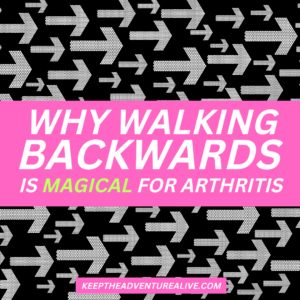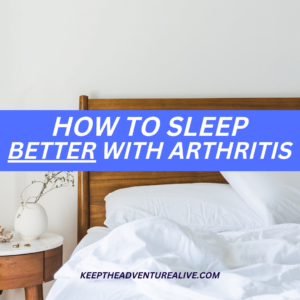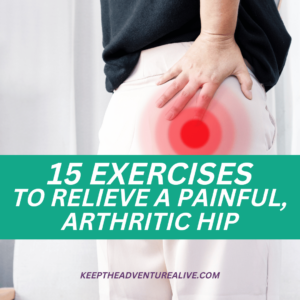Which is better, hiking vs walking? Turns out, you will be able to reap more benefits from hiking with osteoarthritis versus walking on flat ground. Hiking is actually great for your joints once they are prepared. These benefits include: strengthening your muscles, preventing mental illness, improving your balance, and burning more calories when compared to walking on flat ground. Instead of fearing adventure, here you can find the confidence to keep your adventure alive.
Walking is a common form of physical activity in people that are dealing with osteoarthritis. But have you ever thought about hiking instead? Contrary to popular belief, you don’t even need to live in the mountains to go hiking (although it does bring about some awesome views!).
Hiking is a form of walking but is completed in nature, typically on uneven terrain and trails. Hiking challenges your body differently than walking on a flat surface does. There are actually very important benefits that hiking can offer over traditional walking.
If you are dealing with joint pain, hiking can be challenging at times especially when going up and down steeper hills. Many times it actually isn’t the pain that is the most limiting though…
Fear can take over and you may become scared and/or hesitant to try hiking. This can lead people to commonly choose walking on flat ground when given the option of hiking vs walking because it feels safer.
There are many things that can cause you to question your ability to hike. It could be a lack of balance, hesitation with climbing and descending hills, and/or anticipation of pain that can influence your decision.
Hiking with osteoarthritis is actually recommended once your joints are ready. When it comes to hiking vs walking, hiking actually comes out on top.
5 reasons hiking is better than walking
Improves Your Balance
You can make serious improvements in your balance when you are hiking. Walking on constantly changing and unpredictable ground, forces your muscles that are in charge of stabilizing you to work in overdrive, but in a good way. These muscles are not challenged very much when on flat ground.
Balance thrives on variation too. The more variable the trail is, the more you have to think and react to keep your balance. This then carries over to daily life when you take a misstep or trip over an object on the floor, you are more likely to react much faster if those muscles are appropriately trained!
Bring on the Happiness
Hiking can actually make you feel happier. Joint pain can be overwhelming, frustrating, and stressful. A 2015 study from Stanford University found that time spent in natural environments (as opposed to busy city settings) calmed activity in a part of the brain that research has linked to mental illness.
Hanging out with Mother Nature also seems to reduce your mind’s propensity to “ruminate”—a word psychologists use for negative, self-focused patterns of thought that are linked with anxiety and depression”.
Hiking with osteoarthritis can release some positive vibes and actually help to make you feel better about the condition compared to regular walking. The combination of fresh air, relaxing sounds of nature, and beautiful scenery can truly help to improve our mood and fend off negative thoughts.
Burns More Calories
Weight loss can make a huge difference to your osteoarthritis pain. It turns out, you burn more calories than walking on flat ground!
“…hiking on uneven terrain increases the amount of energy your body uses by 28% compared to walking on flat ground” according to TIME magazine. This is because you are using more of your muscles and possibly even different muscles than you usually would walking on flat, predictable ground.
You also may feel more fluctuations in your heart rate due to increased intensity when you are going up and down hills. This change in intensity also contributes to a higher calorie burn that you may not be exposed to when walking on flat ground.
Builds Stronger Legs
You can improve your leg strength more when hiking vs walking. The more muscular strength you have, the more supported your joints are.
Especially for knee arthritis, one of the most important treatment tools is increasing your knee support with your own muscles. When walking on flat ground, you are using the same muscles over and over again. When hiking, you are moving in different directions to avoid obstacles, to fit through odd spaces, and to climb.
This variety in your movement can help to work different muscles that are rarely challenged when walking on flat ground or in daily life. This is especially common in muscles that control side to side movement.
Each step may be different as you never know what you will encounter. Your body has to continue to react, thus recruiting muscles it doesn’t normally use in simple movements of daily life.
Reducing Your Risk of Injury
You can actually reduce your risk of injury when hiking. Many times, injuries to muscles in your hips, knees, or ankles are common with repetitive movements such as walking on flat ground.
Osteoarthritis puts you at a slightly higher risk for other injuries because pain can change the way you move.
When you add variety to terrain and which muscles you are using, it helps to prevent the risk of overuse. Running and walking on flat ground tend to be very repetitive. Your mechanics don’t change a whole lot because the terrain is relatively consistent.
You are usually recruiting the same muscles for each step with limited variability. When you are hiking with osteoarthritis, you will add variety to your stepping patterns and movements. This will help to give you more well rounded leg muscles, thus reducing your chance of injury.
What to think about before your hiking adventure:
Aside from all of these benefits explained above, there are some risks when hiking, especially when dealing with joint pains. Here are a few considerations you should make before going hiking with osteoarthritis:
- Start slow. Going 0-100 can be irritating to our joints so we want to make sure we aren’t asking too much of them. In order to get the most enjoyment out of hiking, start with minimal hills. Do some research on Alltrails (my favorite, free hiking guide that has information trails all over the world) to find out the elevation gain (how steep the trail is) and the level of difficulty. If the trails you start with have steep hills, you may cause more joint irritation- especially with knee arthritis.
- Make sure you are confident in your balance. If you don’t feel confident in your balance, hiking might seem scary. Osteoarthritis can impact your balance, as we said before- pain can change the way we move. With the unpredictable terrain, you have to make sure your balance is adequate to avoid any falls or other injuries. I highly recommend checking out this post to find ideas on how to improve your balance before you start your hiking adventure. You can also use hiking poles, which can not only help you feel more stable but give you more confidence too!
- Make sure you have the right shoes. When walking on unstable surfaces, you need more support from your shoes. When hiking with osteoarthritis, hiking shoes are a necessity. My favorite brand is Salomon but I also like these boots from Columbia. It is worth investing good shoes, especially if you will be hiking at least 3-5 times a month. There is nothing worse than hiking in uncomfortable shoes. You have to take care of your feet, especially if you have arthritis. Hiking boots will give you more support, more stability, and more traction.
- Nature is unpredictable. This goes with general hiking guidelines that nature is unpredictable so we have to be prepared. Depending on where you live, trails could include a variety of wildlife, weather conditions, and terrain. Making sure you have appropriate hydration, food, and clothing is important. Arthritis pain does have a tendency to increase in colder temperatures. Find out tips here on how to keep your joints warm and happy.
The best way to prepare your joints for hiking
Hiking is healthy for your joints when they are prepared. This means that they have the appropriate beginning strength and balance to carry you wherever the trail takes you.
Preparing your knees especially can be crucial to how much you enjoy hiking. Here are some quick tips to help you prepare your arthritic knees in particular.
If you have difficulty walking on flat ground, odds are that you are not ready for hiking yet. But, that’s okay! It just means you need a little bit of work.
The video below shows you three things you need to master in order to begin tackling trails.
When should start with flat walking
Even in comparison of hiking vs walking, there are instances where walking on flat ground may be better for you.
Like we talked about above, if your joints aren’t prepared for hiking, it definitely will not be enjoyable. Here are some instances where walking on flat ground might be a better start:
- if you don’t feel confident up/down hills or stairs
- if you have a fall history within the past 12 months
- if you have joint pain walking on flat ground
- if you have a hard time getting up and down from a chair
- if you have a difficult time walking at least 1 mile on flat ground
You can always work up to hiking though to be able to reap all of the extra benefits discussed!
Which is better: hiking vs walking?
It ultimately comes down to what you and your body are ready for. Hiking does carry a few extra benefits compared to flat walking but may not always be appropriate depending on your fitness level, health conditions, and confidence in movement.
Especially if you have osteoarthritis, there are ways for you to start hiking or continue your hiking adventures.
One woman I was working with, started getting knee pain that began to limit her ability to hike and backpack. After using the principles and exercises used to create the Adventurers for Life– she was able to go on an 18 mile backpacking trip- while also keeping up with her friends!
Learn more about the program so you can get out and enjoy the great outdoors even with osteoarthritis below!
Alyssa Kuhn
Disclaimer: This post is for general informational purposes only. It should not be used to self-diagnose and it is not a substitute for a medical exam, cure, treatment, diagnosis, and prescription or recommendation. It does not create a doctor-patient relationship between Dr. Kuhn and you. You should not make any change in your health regimen or diet before first consulting a physician and obtaining a medical exam, diagnosis, and recommendation. Move Well Age Well, LLC and Dr. Alyssa Kuhn, PT, DPT are not liable or responsible for any advice, course of treatment, diagnosis or any conclusions drawn, services or product you obtain through this video or site. This post may contain affiliate links that give us a small commission with no extra cost to you.




